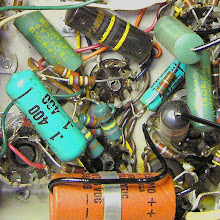
I'm focusing here on the 12DW7 / ECC832 partly out of curiosity and partly because it's half the work to rebias for the new tube. What is a 12DW7? Technical details can be found in the 12DW7 mod part 2.
The goal of the mod is to get a good bedroom level clean sound with a more useful range in the volume control. You can lower the gain and get more headroom by substituting a 12AT7,12AY7 or 12AU7 for the 12AX7. It won't be biased properly, but you may like the sound anyway and you're not going to hurt anything.
You can also plug a 12DW7/ECC832 in place of a 12AX7. A 12DW7 / ECC832 is one half 12AX7 and one half 12AU7. If you like the sound, try this mod to bias the lower mu half of the tube correctly.
THE UBIQUITOUS DISCLAIMER: AKAVALVE ASSUMES NO RESPONSIBILITY FOR THE SAFETY OF ANYONE IMPLEMENTING THESE INSTRUCTIONS. IF YOU ARE NOT FAMILIAR WITH SAFE PRACTICE IN HIGH VOLTAGE CIRCUITS, DO NOT ATTEMPT THIS YOURSELF.
All it takes is a 12K resistor jumpered in parallel with the stock 100K plate resistor R8 and a 1K resistor in parallel with the 1.5K cathode resistor R2. They're the two dark brown 3 watt IRC resistors shown in the middle of the picture.

The effect of putting 2 resistors in parallel is to reduce the overall resistance:

So the stock plate resistor in parallel with the additional 12K one gives a combined value of 10.7K for the plate. This greatly increases the current through the tube, which is what we need for a 12AU7.
With the current increased we need to change the bias of the stage to suit a 12AU7. With the stock resistor it will be running quite cold. The added 1K resistor in parallel with the stock 1.5K one yields a total resistance of 600 ohms.
If you're interested, the working through of the parallel resistance formula is covered in more depth in the Fat Boost Resistor Value post.
Here's a close up of the plate resistor. This jumpering method makes it very easy to remove the mod if you decide to go back to stock.

You can see below that the joint on the left hand of the plate resistor is not perfect - the solder hasn't flowed onto the lead of the original as completely as one would like. This is just for a listening test though so I didn't bother touching it up.
With this mod in place the amp is much cleaner and much quieter. It's important to note that you should NOT plug a 12AX7 back into the socket with the mod in place. A 12AX7 triode can't handle the amount of current that a 12AU7 triode can, so half of your 12AX7 will be toasted by the rebiased stage.




3 comments:
Hi akavalve and thank you for sharing you knowledge and experience !
I'm new in tube amps (but I know basic electronic) but I'm starting to be familiar with fender amps wiring after a couple of weeks of reading sites, forum and books (The Guitar Amp Handbook by D. Hunter).
I'm not sure to understand the interest in the 12DW7 mod against a 12AT7,12AY7 or 12AU7 for the 12AX7.
With the 12DW7, only half of the tube should be rebiased ?
What is the interest in substituting preamp tube instead of lowering the volume ? Is it a way to overdrive the preamp at a general lower volume ?
Best regards,
Eric
I've read on harpamps that a good idea for a harp amp is to increase the power supply voltage dropping resistor (r12 on the champion 600 I figured...), so that the 12ax7 plates would get less voltage, making it a bit dirtier at any level and more ballsy.
Trying to confirm this information, some people have increased the 10k to 22k to have less overdrive on higher levels, and then I got confused.
I'd like to try messing with this resistor, but I am not sure the best way to start...
One thing that definetly helped using the champion 600 with harmonica was adding a mid and treble pots, and changing the .047 mid cap to 0.033. Tone got fatter and less prone to feedback, but still not as dirt as I wanted...
Can you share any thoughts on this?
Tks!
André
Post a Comment